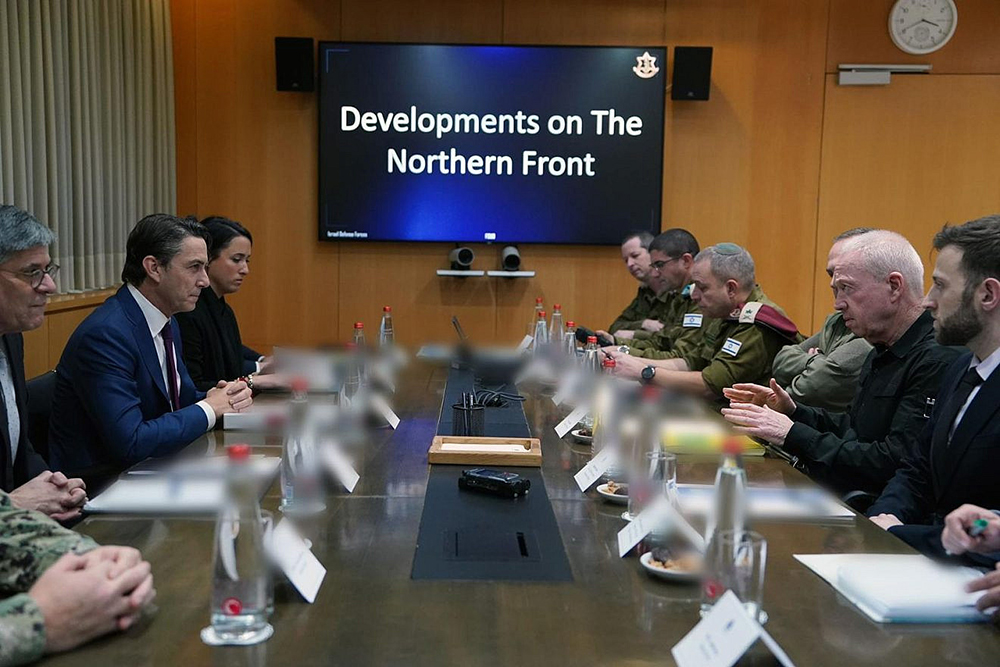|
Getting your Trinity Audio player ready...
|
By: Charles Bybelezer
Israeli Defense Minister Yoav Gallant met on Sunday night in Tel Aviv with senior White House envoy Amos Hochstein, who has been mediating a potential agreement to stave off full-blown war between Israel and Hezbollah.
Gallant emphasized Jerusalem’s commitment to improving the security situation along Israel’s northern border by removing the threats of infiltration and rocket fire from Lebanon.
“We are committed to our citizens. We are ready to resolve this crisis via diplomatic understandings, however we are also prepared for any other scenario,” said Gallant.
He expressed his appreciation for Hochstein’s efforts in addressing the security issues in the northern arena and mindfulness of the 80,000 Israelis who remain displaced from the region due to the ongoing low-intensity conflict with Hezbollah.
During his trip, Hochstein also met with Prime Minister Benjamin Netanyahu, President Isaac Herzog and War Cabinet Minister Benny Gantz.
In October 2022, Hochstein mediated a deal between Israel and Lebanon delineating their maritime border and allowing Beirut to exploit natural gas in its territorial waters.
Since Hamas’s Oct. 7 massacre, Hochstein has been conducting shuttle diplomacy between Jerusalem and Beirut with a view to negotiating a deal for Hezbollah to withdraw its forces several miles from the border. (U.N. Security Council Resolution 1701, forged in the wake of the 2006 Second Lebanon War between Israel and Hezbollah, called for the terror group to withdraw beyond the Litani River, some 25 miles north of the Israeli border).
Israel’s Channel 12 reported that the American envoy on Sunday conveyed “signs” of a possible diplomatic solution.
Israeli media reported this weekend that the latest draft proposal includes three phases: First, an interim agreement for Hezbollah to withdraw its terror forces 8-10 kilometers (4.9-6.2 miles) from the border; second, the deployment of U.N. forces and the Lebanese army to that zone; and third, the return of residents to northern Israel and to Southern Lebanon.
The deal would also include talks on demarcating a permanent land border between Israel and Lebanon and possible incentives for Beirut.
Hezbollah is demanding that Israel surrender territory to Lebanon (specifically, 17 locations) from Nahariya in the west to the Syrian border.
The Blue Line demarcating the 75-mile-long border was created in 2000 by U.N. cartographers to verify Israel’s withdrawal from Lebanon, which the U.N. Security Council later certified as complete. The frontier runs from Rosh HaNikra on the Mediterranean coast to Mount Dov on the border with Syria.
Hezbollah never recognized the Blue Line and disputes numerous points along it.
International peacekeepers from the U.N. Interim Force in Lebanon (UNIFIL) have been deployed in Southern Lebanon to monitor the region since 1978.
Last month, Hezbollah terror chief Hassan Nasrallah hailed “a historic opportunity” for Lebanon to regain control of disputed borderlands “after this phase [of fighting] ends and after the aggression on Gaza.”
Hezbollah’s terror army comprises a combination of 150,000 missiles of all ranges and an estimated 25,000 active-duty fighters, many of whom are veterans of the wars in Syria, Afghanistan and Iraq. The combined force is believed to have plans to invade and occupy large swaths of the Upper Galilee and destroy strategic installations across Israel while inflicting tens of thousands of casualties.
The Washington Post recently reported that Israel had told the United States that the time frame to distance Hezbollah from the border via a diplomatic agreement was the end of January.
(JNS.org)




